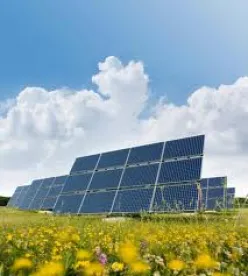We live in an energy age. From our homes to our cars to the electronic devices we depend on, we have become an increasingly energy dependent society. The effects of our energy demand and consumption have become equally ubiquitous and this fact has not been lost among our religious communities. Many denominations concur that climate change and environmental sustainability is a moral issue and mankind has a responsibility to be a steward of creation. It’s a lofty message, but doing the right thing, spiritually speaking, can be as easy as changing a light bulb.
Congregants of many houses of worship throughout the country are putting their environmental stewardship into practice by monitoring their energy consumption and installing solar panels near their steeples. The sun — the power plant in the sky — bathes the Earth in ample energy to fulfill the world’s power needs. Solar power is free, inexhaustible and does not create carbon dioxide emissions. The Dali Lama put solar panels on the monastery in Tibet. Pope Benedict XVI, known as the “green pope,” placed more than a thousand solar panels on the roof of the Audience Hall in Vatican City generating enough clean energy to supply heating, cooling and lighting for the building. Many religious organizations are following the examples of these leaders of faith and working to improve their religious organizations energy use and energy efficiencies.
Religious organizations around the globe have tried to decrease their carbon footprint and invest in solar-generated power. While the upfront costs of installing solar panels are not insignificant, the eventual savings are worthwhile.
- In March 2013, Morningside Hyde Park Presbyterian Church in Ontario, Canada installed solar panels on their building. Their enthusiastic quest for solar-generated power began in 2009, but was quashed by the $200,000 cost of the project. Fast forward to 2011 when the costs of labor and products related to solar panels dropped to $50,000. This reinvigorated the church, and congregants and friends of the church community made donations and granted loans to pay for the panels.
- Elon Community Church in North Carolina installed 20 solar panels at their community center last year, after overcoming some financial hurdles. The 5-kilowatt solar power system is designed to eventually save the church $1,100 per year in energy costs. For most businesses there are tax and rebate incentives for eco-friendly home and building upgrades, but the same isn’t true for churches because they don’t qualify due to their tax-exempt status. The Elon church developed a unique funding model that involved individual donors and church members who formed an LLC. (An LLC is a Limited Liability Company that is a flexible form of enterprise blending partnership and corporate structures, providing limited liability to an organization). The LLC was eligible for those available tax incentives and rebates.
- First Unitarian Church of Cleveland similarly installed solar panels under an LLC. Solar Action, LLC was the solar panel installer used by the church. The company rented the roof space from the church and installed 380 high-tech solar panels ($500,000 worth of technology). These solar panels generate over 91,000 watts, enough to supply the yearly power needs of about ten homes. The system is large enough to generate 80% of the church’s annual power needs. The company will lease the system for ten to fifteen years. After that time, the company will have it appraised and either donate it or sell the system to the church. Solar Action, LLC will sell the power to the church at a price of .02 per kilowatt, and those monthly payments, together with the 30% federal tax credit that would not have been available to the church, will help pay for the system. The church spends about $12,000 a year on electricity for the 88,000 square foot church, even after converting their lighting to compact fluorescent energy efficient bulbs.
- First Congregational Church in Asheville, Tennessee installed 42 solar panels on its roof. Again, because the church couldn’t apply for any state or federal tax credits related to this project, they set up First Church Solar, LLC, which included six private investors and qualifies the $50,000 solar installation for a 65% tax credit. Rather than just generating electricity for the church, the 10-kilowatt system is connected to the electrical grid and helps generate energy for others. The investors are expected to recoup their money in five years. The LLC plans to donate the solar panels to the church, which will then benefit from the guaranteed money by the solar rentals amounting to about $22,000 annually.
- Glen Carr United Church also went green by installing 44 solar panels in February 2013. Their solar panels were connected to the electrical grid in Ottawa, Canada on a 20-year contract with Hydro-Canada, which will pay the church for the power generated. The expected revenue is more than $6,700 a year from the energy it produces.
- The Church of the First Assembly of God in Shrewsbury, New Jersey installed a 30-kilowatt solar system offsetting 52% to 90% of the building’s consumption. The solar panels will dramatically reduce the church’s utility costs and free up valuable capital for other church missions. This project was a success, in that it helped the church in their mission to provide the double bottom line benefits of improving the environment and saving the church money.
- The Unity Church in Boulder, Colorado is offsetting close to all of its energy use from the solar panels it installed in 2010. The congregation raised close to $100,000 through donations and fundraisers to purchase 233 solar panels. Lafayette-based Bella Energy supplied and installed the solar panels. Despite the church’s tax-exempt status, it received $60,000 in federal tax breaks by working with Bella Energy to create an entity called Community Solar Partners that would legally own the array. The church won’t use all of the 60,000 kilowatt hours of energy per year that will be generated. Xcel Energy has paid $90,000 up front for the excess energy, which will be fed into the grid and it will pay the church $3,000 each year for the next 20 years.
See Part II“Let There Be Light” Religious Institutions and Green Energy




 />i
/>i

